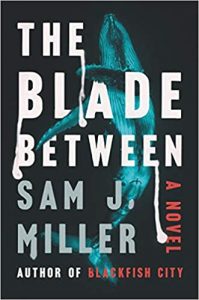Gary K. Wolfe Reviews The Blade Between by Sam J. Miller
 The Blade Between, Sam J. Miller (Ecco 978-0-06-296982-8, $26.99, 384pp, hc) December 2020.
The Blade Between, Sam J. Miller (Ecco 978-0-06-296982-8, $26.99, 384pp, hc) December 2020.
In both of Sam J. Miller’s YA novels, The Art of Starving and Destroy All Monsters, Hudson High School – presumably a version of the same small-town high school that Miller attended in upstate New York – is nearly as powerful an antagonist as the supernatural forces that threaten Miller’s outsider heroes. With The Blade Between, the whole town of Hudson becomes a central character, and most of the human characters seem to have known each other in that high school: Ronan, now a successful Manhattan photographer but whose high school years were a nightmare of bullies and homophobia; Dom, his former boyfriend, now a Hudson cop; Attalah, Dom’s wife, working for Child Protective Services; Zelda, who works under Attalah but has fallen on hard times; Stubby, Ronan’s bully nemesis from high school; Treenie, a prom-queen type now working as a real estate agent, thoroughly in the pocket of the developers who are threatening to completely remake Hudson as an upscale hipster haven. Other characters include Ronan’s increasingly debilitated father, whose refusal to sell out has hindered the plans for Hudson’s redevelopment, and a tech billionaire named Jark Trowse, who’s running for mayor in order to fully consolidate his control of the town. The fact that so many of the central characters were schoolmates, together with the town’s cryptic history (an unlikely whaling port more than a hundred miles from the ocean, later a center of prostitution) and a particularly worrisome ghost, lends an odd Scooby-Doo undertone to what is otherwise an increasingly grim and sharp-edged novel.
The main engine of the novel’s power, and a pretty bold decision on Miller’s part, is hate, which is described early on by Ronan as “the blade that Hudson lodged ages ago between your ribs,” and which later manifests itself among other characters as something more than mere metaphor. Initially, Ronan’s hate for Hudson, fueled by memories of homophobic beatings and small-town intolerance, makes him dread the trip home to visit his ailing father, even though an attractive young model named Katch – whom he met only days earlier – persuaded him to go. Since Ronan’s first-person chapters alternate with third-person chapters focusing on Dom, we learn before Ronan does that Katch had actually committed suicide a month earlier, thrusting us into what is now a ghost story. Once Ronan arrives home, though, his abiding hatred for the town almost reverses itself, as he joins with a group of locals, led by Dom’s wife Attalah, in trying protect the town from the wholesale takeover by those opportunistic developers led by Trowse, and from the trendy New York “invaders” who have already turned the historic downtown into a festival of antique shops and overpriced coffeehouses. This resistance, which begins with a kind of guerrilla effort at discomfiting the new guests with insulting banners and lapel pins reading “You Are Hated,” rapidly escalates to violence, vandalism, and a particularly vicious kind of sexual blackmail. Some of the protestors, like Zelda, begin to take matters into their own hands, but even more fearsome is a demonic ghost, named Tom Minniq and somehow conjured by Ronan’s own nightmares and Photoshop skills. Ronan initially thinks of him as an online hoax, “my magnificent Frankenstein sex bot,” but it soon becomes apparent that Minniq is much more, and has his own plans.
While the supernatural elements of The Blade Between rapidly gain momentum in the second half of the novel, leading to a stunning and tragic conclusion, the central issues – a town resisting gentrification, Ronan’s increasingly ambivalent feeling about a hometown he was once glad to escape, predatory capitalism, community organizing – hardly need vengeful ghosts to develop resonance. The power of hate, though, which comes up again and again in the novel and is almost an obsession with Ronan, gains quite a bit from Miller’s deployment of the otherworldly, especially once we get outside of Ronan’s head. His own musings, unfortunately, sometimes lead toward therapeutic bromides – “to hate something is to cleave your soul to it,” “hate was a drug,” “I was so focused on how much I hated this place that I never saw how much I also loved it,” “it’s okay to love something that you hate,” etc. The ghostly Tom Minniq, though, is considerably less sentimental. In his world, hate is power, an increasingly autonomous force that can demolish communities in an ever-widening, self-consuming feedback loop. In the end, it’s that view of latent, abiding evil – something like Hudson’s own version of Pennywise, only more darkly erotic – that gives The Blade Between its considerable power. We may find it comforting that Ronan eventually comes to terms with his own hate, but we ought to be absolutely terrified of what Tom Minniq represents.
Gary K. Wolfe is Emeritus Professor of Humanities at Roosevelt University and a reviewer for Locus magazine since 1991. His reviews have been collected in Soundings (BSFA Award 2006; Hugo nominee), Bearings (Hugo nominee 2011), and Sightings (2011), and his Evaporating Genres: Essays on Fantastic Literature (Wesleyan) received the Locus Award in 2012. Earlier books include The Known and the Unknown: The Iconography of Science Fiction (Eaton Award, 1981), Harlan Ellison: The Edge of Forever (with Ellen Weil, 2002), and David Lindsay (1982). For the Library of America, he edited American Science Fiction: Nine Classic Novels of the 1950s in 2012, with a similar set for the 1960s forthcoming. He has received the Pilgrim Award from the Science Fiction Research Association, the Distinguished Scholarship Award from the International Association for the Fantastic in the Arts, and a Special World Fantasy Award for criticism. His 24-lecture series How Great Science Fiction Works appeared from The Great Courses in 2016. He has received six Hugo nominations, two for his reviews collections and four for The Coode Street Podcast, which he has co-hosted with Jonathan Strahan for more than 300 episodes. He lives in Chicago.
This review and more like it in the November 2020 issue of Locus.
 While you are here, please take a moment to support Locus with a one-time or recurring donation. We rely on reader donations to keep the magazine and site going, and would like to keep the site paywall free, but WE NEED YOUR FINANCIAL SUPPORT to continue quality coverage of the science fiction and fantasy field.
While you are here, please take a moment to support Locus with a one-time or recurring donation. We rely on reader donations to keep the magazine and site going, and would like to keep the site paywall free, but WE NEED YOUR FINANCIAL SUPPORT to continue quality coverage of the science fiction and fantasy field.
©Locus Magazine. Copyrighted material may not be republished without permission of LSFF.






